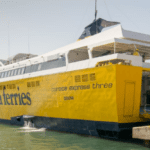Introduction to Camping and the Importance of Choosing a Good Campsite
Camping is more than just a getaway; it’s an escape into nature, a chance to disconnect from the hustle and bustle of everyday life. But before you pack your bags and head out for that much-anticipated adventure, there’s one crucial step you need to take: choosing the right campsite. The perfect spot can make all the difference between a memorable outdoor experience and one you’ll want to forget.
Imagine waking up to the sound of birds chirping, surrounded by towering trees or rugged mountains. Or picture gathering around a crackling campfire under a blanket of stars. These moments are often defined by where you set up camp. With so many options available—each offering unique experiences—it’s essential to find that ideal location that suits your needs.
Whether you’re planning to hike through remote wilderness or enjoy family-friendly amenities, finding the best campsite is key to unlocking unforgettable memories. Let’s explore how you can select the right spot for your next adventure!
Camping offers a unique escape from the bustle of everyday life. It’s an opportunity to reconnect with nature, recharge your spirit, and create lasting memories under the stars. However, the success of your adventure often hinges on one crucial decision: selecting the right campsite.
Choosing where to set up camp can make or break your experience. A great site provides comfort and safety while allowing you to enjoy all that nature has to offer. With countless options out there—from serene lakesides to rugged mountain vistas—how do you find that perfect spot?
In this guide, we’ll explore everything you need to consider when choosing a campsite for your next outdoor adventure. Whether you’re a seasoned camper or new to the scene, understanding what makes a campsite ideal will enhance your journey into the wild. Let’s dive in!
Types of Campsites: Primitive, Developed, and Dispersed
Campsites come in various styles, each offering its own experience. Primitive campsites are the most basic option. They often lack amenities like running water or toilets, creating a true back-to-nature vibe. Here, you can immerse yourself in the great outdoors and enjoy solitude.
Developed campsites cater to those who prefer more comfort. Facilities often include restrooms, showers, and picnic areas. These sites are typically found in national parks or state parks and offer easy access to hiking trails and other recreational activities.
Dispersed camping is another exciting choice for adventurous spirits. It allows campers to set up anywhere on certain public lands as long as they follow Leave No Trace principles. This type of camping provides freedom but requires good navigation skills and self-sufficiency since amenities are minimal or nonexistent. Each campsite type offers unique opportunities for exploration tailored to your preferences.
Factors to Consider When Choosing a Campsite: Location, Amenities, and Safety
When selecting a campsite, location is crucial. Think about proximity to hiking trails, water sources, and scenic views. The perfect spot can enhance your outdoor experience significantly.
Amenities also play a role in your decision-making process. Some campsites offer restrooms, picnic tables, or fire pits. If you’re looking for comfort and convenience, these features might sway your choice.
Safety cannot be overlooked. Research the area’s wildlife and natural hazards like floods or fires. Check if the campsite has clear boundaries and guidelines for emergencies.
Consider accessibility as well. A site that’s easy to reach saves you from unnecessary stress after a long drive. Make sure you know what type of terrain you’ll encounter when arriving at your chosen destination.
Think about noise levels around potential sites—quiet spots promote relaxation while louder areas may detract from the tranquility many seek in nature.
Researching and Reserving Campsites: Online Resources and Booking Tips
Finding the perfect campsite starts with thorough research. Numerous online resources can help you explore options based on your preferences and location.
Websites like ReserveAmerica, Recreation.gov, and Hipcamp offer extensive listings of campsites across the country. They provide essential information such as site availability, amenities, and user reviews.
Social media platforms can also be goldmines for inspiration. Join camping groups or follow outdoor enthusiasts who share their experiences and recommendations.
When reserving a site, consider booking well in advance. Popular spots fill up quickly during peak seasons. Look out for cancellation policies to avoid surprises if plans change.
Don’t forget to verify any required permits or fees that may apply to specific areas. Always double-check directions and accessibility so you arrive prepared for an adventure ahead!
Packing Essential Gear for Your Chosen Campsite: Tent, Sleeping Bag, Cooking Equipment, etc
Packing the right gear can make or break your camping experience. Start with a sturdy tent that fits your needs. Consider factors like size, weight, and weather resistance. A good tent protects you from rain and wind while providing a cozy space to rest.
Next up is the sleeping bag. Choose one rated for the temperatures you expect during your trip. A comfortable sleeping pad can add insulation and cushioning, ensuring a restful night under the stars.
Don’t overlook cooking equipment. A portable stove and lightweight cookware will simplify meal prep in nature. Pack essential utensils, plus easy-to-cook food items like pasta or freeze-dried meals.
Remember personal items like sunscreen, insect repellent, and first-aid supplies. These essentials enhance safety while allowing you to enjoy every moment outdoors without worry.
When you’re ready to head out on your camping adventure, having the right gear is crucial. Your chosen campsite will dictate some of what you need, so it’s important to pack wisely.
Start with a quality tent. Look for one that suits the size of your group and can withstand different weather conditions. A good tent keeps you dry and cozy at night. Next up is a sleeping bag—choose one rated for the temperatures you expect during your trip. Consider packing an inflatable sleeping pad for extra comfort; it adds insulation from the ground too.
Cooking equipment is another essential aspect of preparing for camp life. A portable stove or campfire grill allows you to whip up delicious meals outdoors. Don’t forget fuel, pots, pans, and utensils! If you’ll be cooking over an open fire, bring along fire starters or matches as well.
Packing food smartly can make all the difference in enjoying your time outdoors. Non-perishable items are great choices; think canned goods or freeze-dried meals that just require hot water to prepare.
Don’t overlook other essential gear like first aid kits, flashlights or lanterns, insect repellent, and multi-tools which are handy in various situations.
By ensuring you’ve packed these essentials based on your specific campsite’s characteristics and amenities available nearby, you’re setting yourself up for a memorable outdoor experience filled with adventure and relaxation under the stars.
Setting Up Camp: Tips for Pitching a Tent and Building
Setting up your campsite is a crucial part of the camping experience. A well-pitched tent can mean the difference between a restful night and an uncomfortable one. Start by selecting a flat, dry area to pitch your tent. Look for ground that’s free from rocks and debris to ensure you have a comfortable sleeping surface.
When it comes time to set up your tent, lay out all parts first. Familiarize yourself with the instructions if you’re using a new model; this will save time and frustration later on. If possible, practice setting it up at home before heading out into the wild.
Use stakes properly to secure your tent against wind or rain, ensuring they’re driven deep enough into the ground without damaging them in the process. Use guylines as needed for extra stability.
Once your shelter is secured, focus on creating functional outdoor living spaces. Set up cooking areas away from where you sleep but close enough for convenience. Organizing gear effectively will help keep things tidy throughout your trip.
For those who enjoy campfires, pick a safe spot away from tents and vegetation for fire building; use existing fire rings when available! Gather wood ahead of time—wood should not be taken from live trees or plants—and make sure it’s dry for optimal burning.
Remember that safety is paramount while enjoying nature’s beauty! Properly extinguish any fires before leaving site each day or when retiring at night to avoid hazards like wildfires.
With careful planning and attention to detail during setup, you’ll create an inviting space that enhances every moment spent outdoors—making memories worth cherishing long after you’ve returned home.










